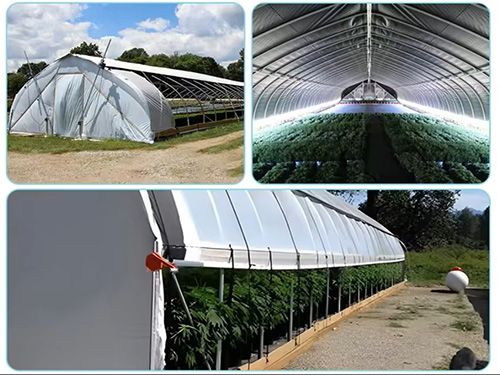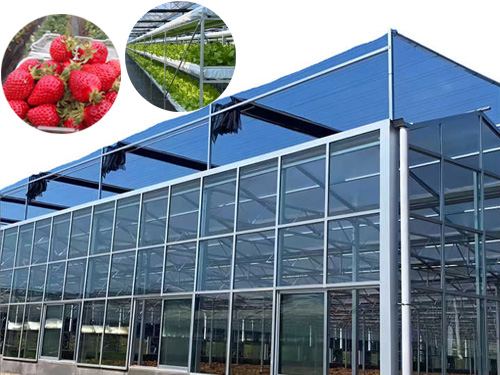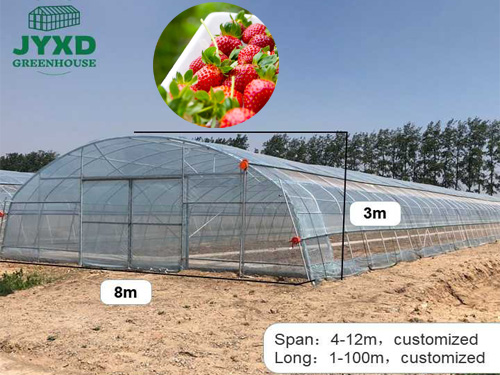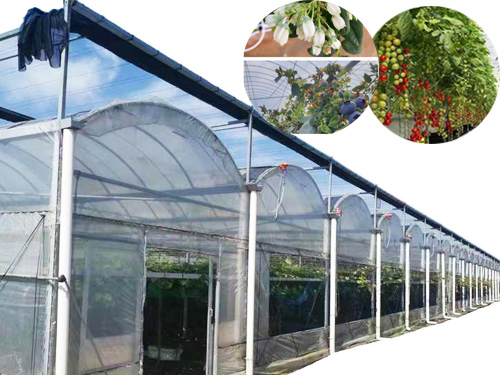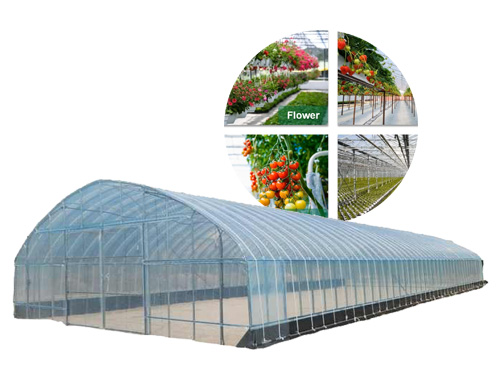NEWS DETAILS
NEWS INFORMATION
Winter Greenhouses: How to Maintain Crop Growth in Cold Seasons
AUTHOR:jyxd-greenhouse DATE:2025-03-03 02:06:08 HITS:63
Winter greenhouses are essential for maintaining crop production during the cold months when outdoor growing conditions are less favorable. By creating a controlled environment, winter greenhouses allow farmers to grow crops year-round, even in regions with harsh winters. This article explores the key strategies for maintaining crop growth in winter greenhouses, ensuring healthy plants and consistent yields.
1. Importance of Winter Greenhouses
Winter greenhouses provide a crucial solution for extending the growing season, enabling the production of crops even when outdoor temperatures are too low for farming. The benefits of winter greenhouses include:
• Year-Round Crop Production: Grow crops continuously, even during winter, to meet market demands.
• Protection from Frost and Snow: Safeguard plants from extreme cold, frost, and snow accumulation.
• Enhanced Control over Environmental Factors: Regulate temperature, humidity, and light for optimal growing conditions.
• Reduced Reliance on External Weather Conditions: Shield crops from unpredictable winter weather and temperature fluctuations.
By maintaining an optimal environment, winter greenhouses provide a stable growing space for high-value crops, such as leafy greens, herbs, and even some fruiting vegetables, throughout the cold season.
2. Key Considerations for Winter Greenhouses
Successfully maintaining crops in winter greenhouses requires careful attention to several key environmental factors.
Temperature Control
• Heating Systems: To combat the cold, winter greenhouses need effective heating systems to maintain a temperature range suitable for plant growth. Common heating options include electric, gas, and hot water systems.
• Insulation: Proper insulation reduces heat loss and helps keep the greenhouse temperature stable. Insulated glazing materials, such as double or triple-pane glass, provide better heat retention.
• Nighttime Temperature Management: Temperature fluctuations between day and night can stress plants. Using thermal screens or heat-retaining materials can help maintain consistent temperatures during the night.
Light Management
• Supplemental Lighting: With shorter days during winter, plants may not receive enough natural light. Installing energy-efficient LED grow lights helps extend the daylight hours, promoting photosynthesis and healthy growth.
• Light Intensity: Adjust the light intensity and duration based on the specific requirements of the crops being grown. Use timers and dimmers to regulate light exposure.
Humidity and Ventilation
• Humidity Control: Winter air tends to be dry, which can lead to issues like dehydration and dry leaf tips. Humidifiers can help maintain ideal humidity levels for plant health.
• Ventilation: While the cold weather can make ventilation a challenge, proper airflow is necessary to prevent the buildup of excess humidity, which can lead to mold and mildew. Automated ventilation systems with humidity sensors can help regulate airflow without causing significant temperature fluctuations.
Wind Protection
• Windbreaks: Cold winter winds can damage crops and reduce the effectiveness of heating systems. Adding windbreaks or using greenhouse covers that shield plants from wind exposure helps protect crops.
3. Selecting the Right Crops for Winter Greenhouses
Not all crops are suited to winter growing conditions. Selecting the right crops is essential for success in a winter greenhouse.
Cold-Hardy Vegetables:
• Leafy Greens: Crops like spinach, kale, lettuce, and arugula thrive in cooler temperatures and can withstand light frosts.
• Root Vegetables: Carrots, radishes, and beets grow well in winter greenhouses, as they can tolerate lower temperatures.
• Brassicas: Cabbage, broccoli, and cauliflower are also ideal for winter production, as they are cold-tolerant crops.
Herbs:
• Parsley, cilantro, and thyme are excellent options for winter production, as they prefer cool conditions and grow well in greenhouses.
Specialty Crops:
• Certain crops like strawberries and tomatoes can also be grown in winter with the right environmental controls, although they may require more specific conditions, such as higher temperatures and additional light.
4. Energy Efficiency and Cost Management
While winter greenhouses require more energy to maintain optimal conditions, there are strategies to keep energy costs manageable.
Use of Solar Energy
• Solar Panels: Installing solar panels can supplement greenhouse energy needs, reducing reliance on external energy sources.
• Passive Solar Heating: Positioning the greenhouse to maximize sunlight exposure during the day can reduce the need for additional heating.
Energy-Efficient Equipment
• LED Lights and Energy-Efficient Heaters: Use energy-efficient LED grow lights and low-energy heating systems to reduce operational costs.
• Thermal Curtains and Covers: These materials help retain heat and reduce the need for continuous heating.
Automated Systems for Efficiency
• Use automated temperature, humidity, and light control systems to reduce energy waste and optimize environmental conditions. Sensors and climate control systems can adjust settings in real time based on plant needs, improving energy efficiency.
5. Monitoring and Maintenance for Winter Greenhouses
Regular monitoring and maintenance are critical for ensuring the success of winter greenhouse operations.
• Daily Temperature Checks: Monitor greenhouse temperatures several times a day to ensure they stay within the ideal range for crops.
• Regular Inspections: Inspect the greenhouse structure for any damage from snow, wind, or ice buildup, and repair any issues promptly.
• Watering and Irrigation: Ensure that irrigation systems are functioning properly to prevent water from freezing in the pipes.
• Pest and Disease Management: Even in winter, pests and diseases can still affect crops. Regularly inspect plants for any signs of pests or disease and address issues promptly.
Conclusion
Winter greenhouses provide an excellent solution for maintaining crop growth during the cold season. By effectively managing temperature, light, humidity, and energy costs, greenhouse growers can ensure healthy plants and year-round production. By selecting cold-hardy crops and implementing energy-efficient strategies, farmers can make the most of their winter greenhouse systems.
Would you like to explore specific winter greenhouse technologies or energy-efficient solutions for your operations?
Hebei Juyou Xinda Greenhouse Facilities Co.,Ltd.
Copyright © 2024-2025 https://www.jyxd-greenhouse.com. All Rights Reserved Hebei Juyou Xinda Greenhouse Facilities Co.,Ltd.Copyright





 Current Location:
Current Location:


